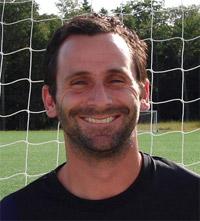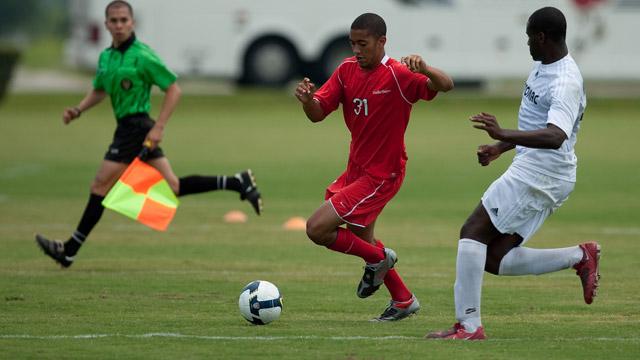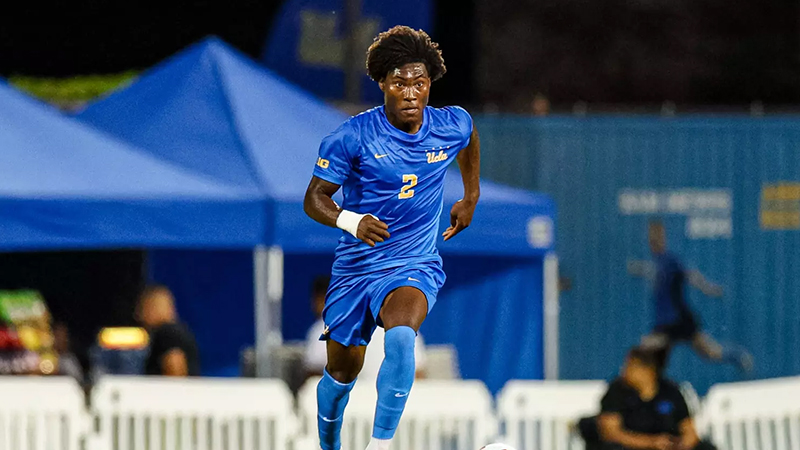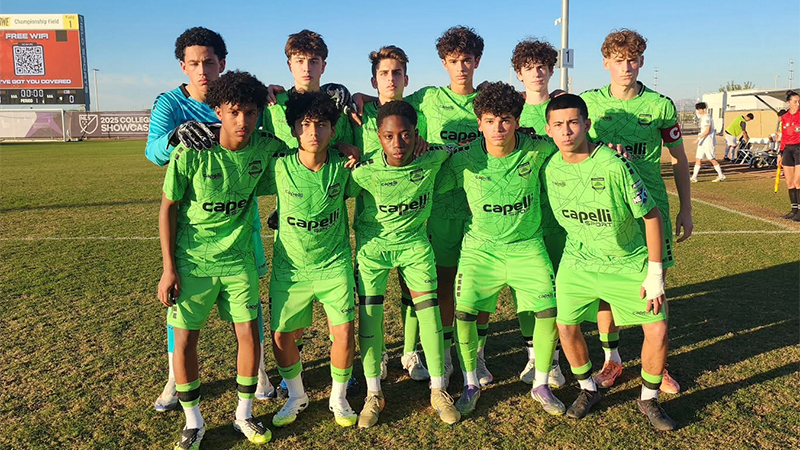 Tony Lepore
Tony LeporeOutstanding issues as the DA moves forward

January 13, 2012
The broad reform and expansion of the YNT scouting network has taken care to include soccer components outside of the USSF Development Academy. U.S. Youth Soccer ODP state coaches for instance, are routinely queried when USSF is making invite lists for the training centers that are such an important part now to the national identification process.
There are, however, some challenges both in organization and relationships that the federation is still contending with as the effort to move American soccer and particularly the National Team ID system into the 21st century. Following is a quick summary:
 Tony Lepore
Tony LeporeU.S. Soccer Development Academy Scouting Director Tony Lepore explained that while the USSF scouting network previously had handled duties for both the boys and girls sides of the game, a separate network is being built under the leadership of WNT Development Director Jillian Ellis.
"It makes sense to be separate," Lepore said. "But when duties cross over we're happy to help."
The nine USSF technical advisers also facilitate the training centers held on the girls' side.
Making the USSF Training Centers and overall Development Academy experience available in some currently underserved areas of the country.
Lepore acknowledged these gaps exist, but stressed that the process still looks to provide opportunities for everyone and continues to be a work in process.
"We still look at expansion as part of the academy process," he said. "Last year we added two clubs and two more the year before that. We monitor the geographic holds in the map closely. Part of the application process, which is ongoing, is to look at clubs as to when they might be ready, not just competitively but administratively, in regard to facilities and that kind of thing. Just because we don't have clubs in a certain area doesn't mean we haven't looked at adding any.
"We also may need replacement clubs for clubs that don't cut it with our development standards," he continued. "We're not talking about major markets with a strong history of developing youth national or senior national team players, but we're still looking to fill in these gaps."
Among the areas Lepore identified as currently in the running for possible inclusion included Louisville, Cincinnati, Oklahoma, Las Vegas, Portland, Western Virginia, Pittsburgh, Eastern New York and Central Florida.
He reiterated that to be in the program a club must have high standards for administration and also funding, particularly as there is a hope that more clubs will move away from a pay-to-play model, at least for the Academy-level teams.
In terms of scouting and player identification, Lepore said USSF has to be smart about using its resources in trying to provide opportunities to players in those areas.
"For individual players, do we have training centers in some of those places when it makes sense, or does it make sense to bring certain kids into an (existing) camp if they are not getting the same exposure to good playing environments because of the player pool around him," Lepore said, citing the example of recent MLS signing Tyler Polak who was identified from his Lincoln, Nebraska base and eventually played in the U17 World Cup before now moving on to the professional ranks. The issues of expansion and geographic coverage are typically a topic when the technical advisers meet on a quarterly basis with U.S. Soccer Technical Adviser Claudio Reyna and the program’s administrative team.
Avoiding an Us vs. Them mentality between Academy and non-Academy clubs.
Lepore sees this evolving for the better as well. He noted that early training centers were sometimes boycotted by certain clubs because they felt the events were simply a glorified venue for player poaching by Academy clubs. Now he sees more and more clubs being willing to work with their Academy counterparts in a cooperative fashion, sometimes even working out a contractual relationship, so that any player movements as talent rises through the age groups, will be friendly and cooperative rather than acrimonious.
He added that even in the event of clubs holding out against the Academy, the increased and improved scouting of the Academy clubs, plus the greater awareness of soccer parents that the Academy can be beneficial to their children’s soccer hopes, are also helping break down these walls.
"To be a good Academy club, like any great club, you have to have scouts. But you can't just have a recruiting model," Lepore said. "You have to have good player development and you have to be ethical. We don't allow recruiting at training centers. We still have a long way to go in some markets. It can still be cutthroat out there. In the past you could just be a strong recruiter and have success in terms of Cup and tournament championships, but we’re seeing more clubs come together for the sake of developing the players and the game."
Integrating Pro Player Development into the largely youth-club setup in this country, in the context of an advanced system of producing talent.
"Pro player development is an important part of the process and presents some challenges, but I think it is really positive," Lepore said. It's really important for MLS clubs to be a big part of youth development as we move toward being on par with the rest of the world. I think they have added to our league, and more recently we've developed a stronger working relationship with their administrative team on the technical side. We need to come together more to help each other more."
Lepore added that it will continue to be a priority for a level playing ground to exist between the non-MLS and MLS, an area of frequent complaint from some clubs in MLS markets.
"Some of the connections need to be strengthened, quite frankly. Competition between neighbors can be healthy," he said. "We want to move away from looking at how we do vs. our neighbors as a measure of success, and instead look at how we are doing compared to the top clubs in the world, something Claudio (Reyna) has mentioned before."
Balancing player development for national and professional teams with the needs of college soccer programs.
Some college coaches have complained that the rules of the Development Academy, including no re-entry, make it harder for them to identify potential college players. Lepore believes that a rising tide lifts all the boats.
"Our goal is still to develop players," he said. They are better when they leave than when they come in. It prepares them for what comes next, whatever that is. I've had college coaches tell me the players they get from the Academy are better at traveling and preparing for games. It's exciting that we have more young players going pro, but we know it's not for everybody, so I don't get hung up on that. Our agenda is to make players better, and that is good for everybody."
Moving to a year-round schedule and the impact it will have on scholastic soccer.
Currently Texas, Southern California and the Pacific Northwest are the three Academy divisions that have gone to a 10-month schedule, meaning no high school participation. Next year this will be an Academy-wide effort, again in an effort to match what is done by top soccer nations, mainly through increasing overall training hours. The arguments against year-round club soccer are well known, but Lepore says the benefits outweigh the negatives, citing more training, fewer double-fixture weekends needed to fill out the schedule and a greater percentage of players coming from a club’s local market as examples.
"Going forward if we can get everyone on the same schedule, we'll not have to worry about teams from the Southeast for instance playing Texas teams who are already 10-12 games into the schedule," he said. "Without having to worry about the high school season, we'll probably be able to realign some of the divisions to help with travel. It would provide continuity, but we know it’s a huge cultural shift.
"We think it has gone off so smoothly in Texas and Southern California and the Northwest. In other parts of the country it will be more of a challenge," he continued. There is a private school issue in the Northeast, where some kids get free tuition or financial aid to be at a school that is not substandard. That can continue. The only issue we have is that we don't want them playing both at the same time. When it comes to personal development we can't compare to what some of these high schools have to offer a young student-athlete, but when it comes to soccer development we hope they acknowledge as well that they can't compare with us. We hope they will get their social development through some other means. We've talked about it for a long time. The time is right and we're ready. Remember, Academy is not just for the most talented, it's for the most talented AND the most committed. When it comes to professional and national team soccer, the ones who put the time in to sacrifice and have the character needed, those are the ones who make it. A big part of character is commitment and grit."
A related issue is moving the competitive age group of the Academy down to U14.
"We're getting close with that one, but the timeline might be a bit longer (than a year-round schedule)," Lepore said. "Everyone recognizes having this trickle down to the U14s would have value. There are some spinoff leagues such as in Southern California and some other places where the clubs are doing it themselves. We’re spending time now seeing how it would look different. It can't be exactly the same league. The travel model we have for our league, for instance, does not fit for the U14s. So we're talking about how to solve those travel gaps. One question is whether it could be a bigger league. The 78 clubs we have now is close to the limit, but does expansion make more sense at U14? It could be a chance to spread the gospel, to fill in the (geographic) gaps and give younger players more opportunities to play meaningful games. We have to remember though that the U14s are an age group in crisis. It’s always the most overplayed age group in the soccer population. But I think we realize starting with the U16s is too late."
Headlines
- Recruiting Roundup: December 15-21
- How Do I Get Scouted by TopDrawerSoccer?
- 2026 Women's Division I Transfer Tracker
- 2026 Major League Soccer Mock Draft
- Women's College Postseason Top 100 Players
-
Top MLS Academy Alumni Performances

-
MLS NEXT Fest: U15/16 Goal-Scoring Stars

-
Commitments: HS Star heads to Portland

-
Player Rankings Spotlight: 2026 Girls

- 2025 Women's DI Postseason Awards
IMG Academy Top 200/150 Rankings



